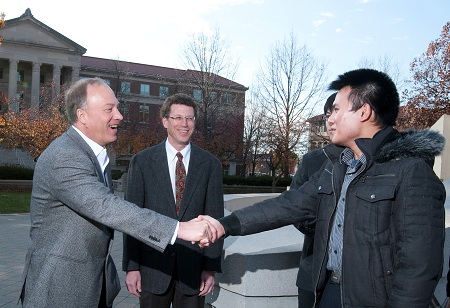ACADEMIA
Purdue, Notre Dame and GE Healthcare partner to make 'ultra low' radiation-dose, high-clarity CT imaging a reality
CT is an advanced form of spiral X-ray technology that physicians use to help diagnosis disease in their patients – including cancer, cardiac and neurological diseases, and other conditions – with the goal of significantly improving treatment plans and patient health outcomes. Since it was invented in the 1970s, CT scanning has positively impacted millions of lives. Still, physicians and patients have traditionally had to balance the tremendous benefits of CT with the patient's exposure to the limited medical radiation dose used during scanning.
Veo is helping change the equation by helping health-care professionals provide accurate diagnoses with high-clarity images at astonishingly low radiation dose levels.
"Veo technology is a game-changer, plain and simple," said Steve Gray, vice president and general manager of CT and Advantage Workstation for GE Healthcare. "Traditionally in CT there has been a need to balance image quality for diagnostic purposes with the lowest achievable radiation dose. We are hearing from our customers that GE is changing the rules of CT with Veo, delivering remarkably clear images at unprecedented low dose levels."
The world's first Model-Based Iterative Reconstruction technology, Veo is built on an advanced algorithm that was developed jointly by researchers at Purdue, Notre Dame and GE Healthcare and is the subject of numerous U.S. and international patents and patent applications. The three organizations signed an exclusive license and commercialization agreement on Monday (Nov. 28) allowing Veo and the underlying MBiR technology to be commercialized by GE Healthcare.
"The development of this discovery is another excellent example of how a collaboration between Purdue and another institution, in this case Notre Dame, as well as an industry leader like GE Healthcare, has resulted in a viable product that is being commercialized," said Joseph B. Hornett, senior vice president, treasurer and COO of the Purdue Research Foundation. "Last year, we signed 85 commercialization agreements to move Purdue discoveries to the public."
"We're pleased to have our engineering research contribute to a viable new product, particularly in an area so critical to our economy and our well-being as revolutionary medical diagnostics devices," said Robert Bernhard, vice president for research at Notre Dame. "We see the Veo project as a great example of close collaboration of university and industry."
Charles A. Bouman, Ph.D., the Michael J. and Katherine R. Birck Professor of Electrical and Computer Engineering and a professor of biomedical engineering at Purdue University, and Ken Sauer, Ph.D., associate professor of electrical engineering at Notre Dame, developed the technology over the past two decades in collaboration with Jean-Baptiste Thibault, Jiang Hsieh and Zhou Yu. Thibault and Yu worked on the technology as graduate assistants under Bouman and Sauer and both currently work for GE Healthcare.
"Conventional CT scanning takes thousands of views from different angles to 'see' organs and then creates a 3-D image of the person," Bouman said. "Veo takes radiographic images digitally that use less X-ray. A reduction in X-rays means the radiation dosage is reduced. Then, our computer algorithm uses model-based reconstruction more effectively so we can form a high-quality image with less radiation.
"Basically, Veo cleans up the noise or graininess and creates a sharper image."
After simultaneously completing their doctorates at Princeton University, Bouman and Sauer began working on the technology as assistant professors at Purdue and Notre Dame.
"Our opportunity to work closely with our collaborators at GE Healthcare was immensely important in getting these imaging ideas into the scanners," Sauer said. "The fact the Jean-Baptiste and Jiang committed themselves to guiding this project and had direct access to other experts on every facet of the machines really tightened the feedback loop on algorithmic improvements."
Funding for the research came in part from the National Science Foundation and GE Healthcare.
"Given increasingly complex clinical demands and the traditional trade-off between CT image clarity and patient exposure to medical radiation, the efforts to develop and test Model-Based Infrared Reflectometry (MBiR) were critical," said Jiang Hsieh, CT chief scientist for GE Healthcare. "These efforts saw results – the potential to lower noise, increase resolution, improve low-contrast detectability and reduce artifacts while maintaining image clarity – and today we're able to offer Veo to physicians around the world, opening the door to high CT image performance at yet unseen low dose levels."
In clinical practice, the use of Veo may reduce CT patient dose depending on the clinical task, patient size, anatomical location and clinical practice. A consultation with a radiologist and a physician should be made to determine the appropriate dose to obtain diagnostic image quality for the particular clinical task
 .
.

